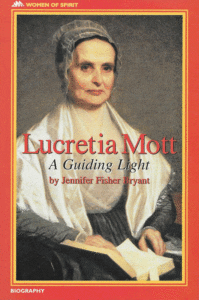
Along with her spiritual inner beauty, Lucretia Mott was a comely woman and mother of six children with her husband of 56 years, James Mott. Lucretia Coffin was born January 3, 1793 in Nantucket, Mass. to Thomas and Anna Folger Coffin. She had one older sister, Martha.
Lucretia was a Quaker, an abolitionist, women’s rights activist, and social reformer. In 1848 she helped write the Declaration of Sentiments during the Seneca Falls Convention. When slavery was outlawed in 1865, she advocated giving former slaves, whether male or female, the right to vote. Her portrait sits at the National Portrait Gallery in Washington, D.C.. It was painted by Joseph Kyle in 1841. 
Like most Quakers, Mott considered slavery to be evil. She refused to use cotton cloth, cane sugar, and other slavery-produced goods. In 1821 she became a Quaker minister.
In 1833 she and her husband founded the American Anti-Slavery Society. Lucretia was the only woman to speak at the organizational meeting in Philadelphia. She preached at black parishes and opened her home to fugitive slaves. Mott and other activists organized anti-slavery fairs to raise awareness and revenue which provided much of the funding for the movement.
When Mott attended the World’s Anti-Slavery Convention in London in June 1840, one Irish reporter deemed her the “Lioness of the Convention.” When the men delegates voted to exclude the six American women from participating, and required them to sit in a segregated area, many men protested the women’s exclusion and sat with them in the segregated area.
Returning to the United States, Mott continued to be active with a public lecture schedule. She travelled to slave-owning states and met with slave owners to discuss the morality of slavery. She had a personal audience with U.S. president John Tyler who was impressed with her speeches.
Mott was a founder and president of the Northern Association for the Relief and Employment of Poor Women in Philadelphia which began in 1846. After the Civil War ended in 1865 she was elected the first president of the American Equal Rights Association which advocated universal suffrage.
In 1849 her “Sermon to the Medical Students” was published. Her speech “Discourse on Woman,” a pamphlet about restrictions on women in the United States was published. In 1864 she and several other Quakers incorporated Swarthmore College near Philadelphia which remains one the of premier liberal arts colleges today.
Lucretia was a pacifist and opposed the War with Mexico (1846-1848). After the Civil War, she increased her efforts to end war and violence and she was a leading voice in the Universal Peace Union founded in 1866.
A version of the Equal Rights Amendment from 1923 was named the Lucretia Mott Amendment. There is a Pennsylvania Historical Marker with a roadside designation for Lucretia C. Mott. Her letters and dairies are housed in several prestigious libraries and universities, including Swarthmore College. In 1948 a 3¢ stamp featured Elizabeth Cody Stanton, Carrie Chapman Cott, and Lucretia Mott. In 1983 Mott was inducted into the National Women’s Hall of Fame
James Mott had worked in Lucretia’s father’s nail business before becoming a cotton and wool merchant. He died in 1868 of pneumonia. When Lucretia Mott died in 1880, she was widely judged by her contemporaries… “as the greatest American woman of the 19th Century.” She was a mentor to Elizabeth Cady Stanton who continued her work.
And so it was that in 1870 the Fifteenth Amendment gave black men the right to vote. Congress passed women’s right to vote June 4, 1919 and the States ratified the Nineteenth Amendment August 26, 1920 to confirm women’s right to vote.

